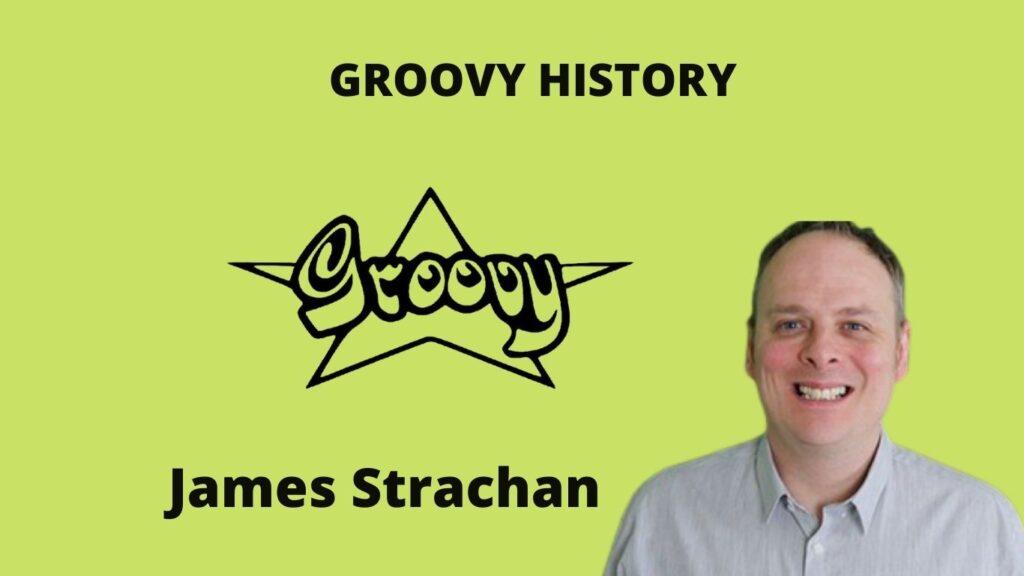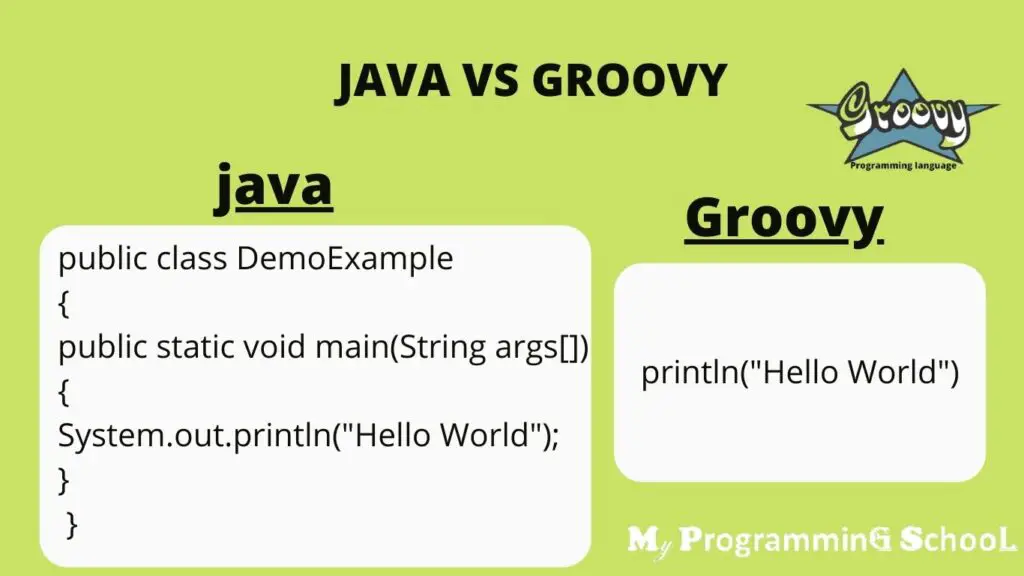Here, we discuss what is groovy language tutorial, why to use groovy, Groovy History, use Groovy language, Groovy features, Groovy example, java vs groovy, and conclusion.
What is Groovy language?
Groovy is an object-oriented programming language for the Java Platform. It is a dynamic language with features similar to those of Python, Ruby, Perl, and Smalltalk.
Groovy can be used as a scripting language for the Java Platform, is dynamically compiled to Java Virtual Machine (JVM) bytecode, and interoperates with other Java code and libraries.

Groovy code is compiled to Java bytecode, thus it can be run on any Java virtual machine (JVM). Groovy can also be compiled to JavaScript source code or used as a compile-time replacement for Java classes. Since it is a dynamic language it does not have types but uses duck typing.
Groovy is a dynamic language, meaning that it has the capability to change the structure of the program while it is running. This is called reflection and allows for features like meta-programming. It also means that Groovy programs can be dynamically compiled to Java bytecode, thus allowing for gradual migration from dynamic scripting languages to statically typed compiled languages.
It was created in 2003 by James Strachan to allow Java developers to write code more easily. The addition of closures made Groovy a fully dynamic language, like Ruby. In 2007, the project was donated to the Apache Software Foundation, which has since overseen its continued development.
Groovy 2.4.0 was released on March 22, 2014. The most recent stable release is 2.5.4, released on October 10, 2017.
Groovy uses many features of Java, so there is a relatively small learning curve for Java developers. However, Groovy adds many features to enable the easier development of simple code and DSLs (Domain-specific languages).
Groovy uses many features of Java, so there is a relatively small learning curve for Java developers. However, Groovy adds many features to enable the easier development of simple code and DSLs (Domain-specific languages).
Why Groovy programming language?
Groovy is a JVM-based programming language, which is compatible with Java. Groovy has a number of features that make it incredibly useful for web developers and programmers. It has been popular for over a decade now and is used by companies like Google, Netflix, Twitter, LinkedIn, and many other renowned brands.
Groovy uses the power of Java but simplifies its syntax. Its dynamic capabilities give it an edge over other languages out there today. There are many new features that have been added to the language recently, which makes it even more enticing to use.
Groovy History
Groovy-lang is a JVM language for the Java Platform. Groovy is dynamically typed and runs on Java Virtual Machine (JVM). Groovy was introduced by James Strachan and Ceki Gülcü in 2000, with the first stable release on July 17, 2003. Groovy 1.0 was released on November 13, 2007. The latest release of Groovy is version 2.5.2, released on May 16, 2017.

In 2011, it was voted as the most loved programming language by StackOverflow users.
It is one of the most dynamic and safest languages now a day. It has new features like Closures, builder, AST transformations, dynamic language features, etc. It can be embedded into any Java program as well as used independently.
How to use Groovy language?
Apache Groovy is a programming language for the Java platform. It is a fully-fledged object-oriented language with features similar to those of Python, Ruby, and Smalltalk.
Groovy can be used as a scripting language for the Java Platform, is dynamically compiled, and has many attractive features for developers including:
Groovy is an object-oriented language that compiles to Java bytecode.
It is a dynamic language with features similar to those of Python, Ruby, and Smalltalk.
Groovy uses a Java-like curly-bracket syntax. Groovy is an agile, dynamic language for the Java platform.
Groovy features
Groovy is a programming language for the Java Platform. Groovy builds upon the strengths of Java but has additional power features inspired by languages like Python, Ruby, and Smalltalk.
10 features of the Groovy language are:
- Groovy source code compiles directly to Java bytecode, so it fits into the Java platform seamlessly.
- Groovy uses a familiar syntax that’s easy to learn if you know Java, C++, C# or Perl.
- Many programmers have found that their productivity using Groovy is greater than with other dynamic languages.
- Groovy supports static compilation, type checking, and static compilation for the development of large applications.
- Groovy has a familiar Java-like syntax, which makes it easy to learn if you know Java or another object-oriented language.
- Groovy is a multi-paradigm language, supporting object-oriented and functional programming.
- Groovy has a dynamic type system that supports duck typing.
- Groovy has powerful metaprogramming capabilities for writing Domain-Specific Languages (DSLs).
- Groovy code can run on any platform that supports the JVM (Java Virtual Machine).
- The platform-independent code allows reducing costs of software development and testing.
Some other Features of Groovy
The Groovy programming language was designed to provide a dynamic, flexible, and highly productive system for Java developers. The following are some of the features that make Groovy special:
- Easy learning curve
- Support for domain-specific languages
- Compact syntax
- Literal declaration for lists (arrays), maps, ranges, and regular expressions
- Support for dynamic typing
- Language level support for maps, lists, regular expressions
- Powerful processing primitives
- Ease to develop web application
- Supports closures, dynamic typing, metaobject protocol
- unit-testing declaration support
- Groovy Scripts can also contain method definitions outside of class definitions.
- A groove can be compiled, and it will be integrated with traditional Java applications.
- It also supports static and dynamic typing & operator overloading
How to use Groovy in Java projects?
Groovy is a dynamic programming language for the Java platform. It is a very simple and fun language that is easy to learn and use. This article will discuss how Groovy can be used within a Java project, and provide some helpful tips on how to get started with Groovy coding.
There are several reasons why you may want to introduce Groovy into your Java projects. Groovy is a good alternative to Java in situations where your application requires non-Java libraries, or if you want to quickly develop scripts and prototypes. Groovy is a great alternative to Java for writing unit tests. Groovy scripts are compiled into Java bytecode, so they can be used in any Java project. Groovy’s dynamic nature makes it easier to write unit tests than with Java.
Groovy example | java vs groovy
If we want to print the same word “Hello World” in java. the code will be like this.
public class DemoExample
{
public static void main(String args[])
{
System.out.println("Hello World");
}
}This code is valid in both Java and Groovy because Groovy is a superset of Java but with Groovy without creating class, function, etc. we can print within a single line
println "Hellow World"
There is no need for any semicolon, no need for parenthesis, and no need to write System.out.println but instead of this we have to write just println.

People also ask
Q) What is Groovy used for?
Groovy is a general-purpose programming language originally developed by James Strachan and Chris Morris in 2003. Groovy is a statically typed programming language for the Java Virtual Machine (JVM), but also can be compiled to JavaScript or native code.
The main focus of Groovy is the syntax that makes coding more enjoyable and less verbose.
Groovy has some powerful features for metaprogramming, such as dynamic typing, metaclasses, and it also allows very compact code without verbosity. All of these features make Groovy a good candidate for Domain-Specific Languages (DSLs). In fact, the Spring framework uses Groovy extensively in its configuration files
Is Groovy a good programming language?
Yes, Groovy is one of the good programming languages and It has been popular for over a decade now and is used by companies like Google, Netflix, Twitter, LinkedIn, and many other renowned brands.
Is Groovy still used?
The Groovy language has been around for more than a decade and is used by many companies. But it’s hard to say whether the language is still in use or not. This paper shows why it’s still being used and what makes it so popular.
It’s no secret that Java has become the most popular programming language for enterprise development. It’s also well-known that Java is slow and cumbersome, which forces developers to look for better alternatives. One such alternative that promised to be faster and easier than Java was Groovy.
Which is the first generation of Groovy language?
Groovy was introduced by James Strachan and Ceki Gülcü in 2000, with the first stable release on July 17, 2003. Groovy 1.0 was released on November 13, 2007.
Conclusion
Groovy is an object-oriented programming language for the Java Platform. It is a dynamic and flexible language that makes developers more productive than ever before. The best way to get started with this technology is to find a mentor or attend a live training course online.
